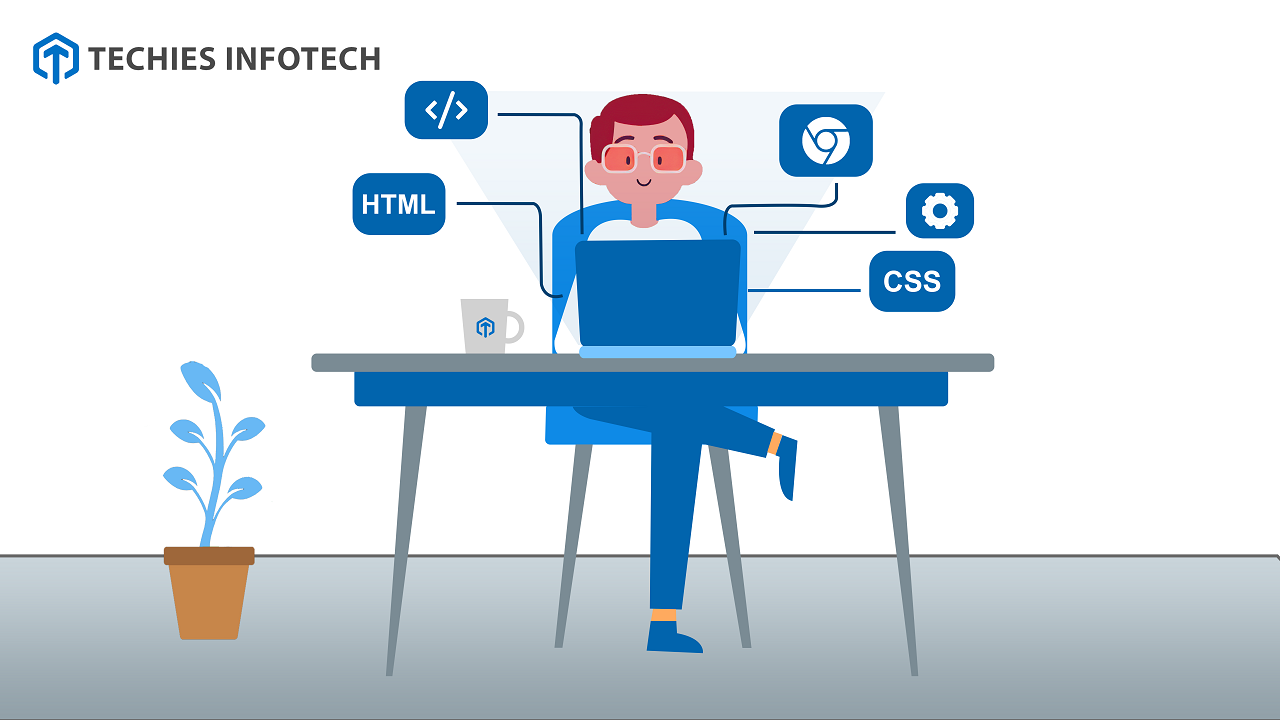A creative and well-optimized UI can boost a website’s conversion rate by 200%, and an interactive UX can increase the conversion rates by 400%.
With numbers like these, the importance of a good user experience for a website cannot be ignored. As businesses are becoming more aware of the UI and UX of their websites to provide a better experience to their visitors, the demand for SEO-friendly, interactive and responsive websites is also growing.
With so much to consider while developing a website, managing everything with coding can be challenging. Fortunately, many front-end web development tools are there to ease the development process.
What are front-end web development tools?
A web development tool is a software application that helps build attractive website layouts and allows you to debug and test the interface of the website and application. Using these tools will accelerate the development process through drag-and-drop and numerous other features to create interactive and compelling web designs.
From plugins and add-ons to processors and frameworks, front-end web development tools can help streamline the code and make the development easier.
There are several front-end development tools for various requirements, such as HTML, JavaScript, CSS, Deployment, code-editing, security, wireframing and prototyping, and more.
With the number of dev tools increasing almost daily, finding the best ones to get the work done smoothly may feel challenging.
Here is the list of top web development tools that make developing the front end of the website easier and faster.
Atom
Atom is a community-built, open-source text and source code editor tool. It is compatible with macOS, Linux, and Windows and offers high levels of customization options. The tool is developed by GitHub using HTML, JavaScript, Less, and CoffeeScript languages.
Atom is the best text editor tool that offers seamless collaborations when working with a team. Additionally, this dev tool allows you to install open-source packages and add additional features through JavaScript and HTML to improve its functionality. Atom is compatible with popular programming languages, including C, C#, C++, Python, R, HTML, CSS, Java, and more.
Key Features
- Collaborative editing
- Syntax highlighting
- Multiple programming language support
- Cross-platform support
- Code folding to show and hide logical sections of the code
Chrome DevTools
Chrome DevTools is a set of debugging tools that are built into the Google Chrome web browser. It allows you to edit the HTML and CSS codes and debug the JavaScript code in real-time. Available in both Apple Safari and Google Chrome, Chrome DevTools allow users to view and change the DOM and page styling, diagnose problems, optimize the page speed, and edit pages in real time.
Chrome DevTools also offers additional features, such as
- Timeline to identify run-time performance problems
- Device Mode to test the responsiveness of a website
- Element Tab to debug HTML and CSS codes
- Performance to optimize the website’s loading speed
- Network Panel to view and debug the network activity
- Sources Panel to debug JavaScript
- Security to identify security concerns on the website
Key Features
- It allows users to view and modify CSS and DOM
- The local override feature allows to save changes made to a webpage on a local computer and override the data automatically.
- Using the lighthouse tool, you can perform web page audits to test the performance, accessibility, SEO, and page speed.
- It has various functionalities for device mode, application panel, network panel, console panel, elements panel, memory panel, security panel, and sources panel.
JQuery
JQuery is a cross-platform JavaScript library that allows you to handle various functionalities, including CSS manipulation, event handling, DOM manipulation and transversing, animation, Ajax and JSON support, and more. It can also be used with other libraries and plugins to add additional features.
JQuery is used by 77.2% of websites and is preferred by 48.7% of web developers.
JQuery is the most popular front-end web development tool because of its ease of creating animations and navigating documents. With better documentation, powerful chaining capabilities, and a huge development community, JQuery is a great web dev tool for front-end development.
Key Features:
- This JavaScript library is very lightweight. The size of the minified and gzipped file is only 30KB.
- The tool makes it easy to select DOM elements, modify their content and transverse them.
- It provides an easy-to-use API for Ajax, animation, and document navigation.
- JQuery is compatible with a wide range of modern browsers like Chrome, Safari, Firefox, Edge, IE, etc.
CodePen
CodePen is a collaborative development environment for front-end developers and designers. This online code editor tool allows editing HTML, JavaScript, and CSS codes.CodePen allows users to add other front-end libraries and frameworks.
In addition, the tool offers various functionalities to develop and share the front end of the website. It also offers all the features and functionalities of an Integrated Development Environment in a web browser so that you can develop the entire website in a web browser.
Key features
- CodePen is a very adaptable and customizable code editor tool with features like Emmet and autocomplete.
- It allows users to drag and drop CSS, images, animations, JSON files, SVGs, media files, and more.
- The collaboration mode allows multiple people to edit the code at the same time.
- CodePen lets you keep pens private.
Git
Imagine working on a new feature in a project, and something goes wrong. A version control system like Git can rescue you in such situations. The tool allows to manage the source code, track changes made in the code, and conveniently roll back to the previous state. Written in C, Perl, Shell, and Tcl, it is an open-source tool that provides unmatched efficiency and support. The tool saves every change made in the project and allows everyone on the team to work on the same code without any code conflict.
Key Features
- Git is 10 times faster than other version control systems
- It makes collaboration easier by including several methods to resolve conflicts arising from multiple users working on the same file.
- It is compatible with almost every operating system used these days.
- A distributed system holds its central repository allowing remote collaborators to access it anytime, anywhere.
NPM
Node Package Manager or NPM is a JavaScript software registry to share and deploy local and global packages. The tool lets you install language-specific packages on your website on demand. NPM simplifies the development process as you don’t have to write new codes to add new functionality to the website.
NPM also provides advanced features like security auditing, de-duplicated development, team management, and access control for seamless usage. The tool is available in three versions – NPM open source, NPM Orgs, and NPM Enterprise.
Key Features
- More than 470,000 free code packages are available in the NPM registry.
- It is a registry for open-source projects, allowing sharing of the source code with other NPM users.
- The team plan allows NPM users to integrate workflows and control permissions within the team.
Grunt
It is one of the best front-end development tools for automating mundane and repetitive tasks. It is a JavaScript task-runner tool that performs various frequent tasks like linting, minification, unit testing, and compilation. The tool comes with several pre-installed plugins for common tasks and is easily expandable.
Users can also write various activities relevant to their project requirements. Grunt can also be used to implement coding style guides throughout the project to ensure consistency.
Key Features
- With the Grunt tool, you can automate most of the monotonous tasks with minimal effort.
- There are over 5,000 plugins available
- Users can also publish their Grunt codes on NPM
- Users can create and modify custom tasks according to the project requirements.
Conclusion
With a wide range of tools available to add various functionalities to a website, it is clear that front-end web development is not just limited to HTML, JavaScript, and CSS. You need to get familiar with various web dev tools to develop a responsive, user-friendly website.
Every successful business requires a website with a clean, attractive, and SEO-friendly front end that attracts customers. Developing such a website requires deep knowledge of various web development tools and technologies.
Get in touch with Techies Infotech, the best web development company, to develop a responsive website with interactive UX design.
Frequently Asked Questions
Which language is most commonly used for front-end development?
HTML is the most commonly used language for front-end development. The language is used to develop websites and web applications. Some other popular front-end development languages are CSS, JavaScript, React, and Angular.
Is JavaScript used for developing the front-end or back-end?
JavaScript is used for both front-end and back-end development. It is a very easy-to-use programming language used for developing attractive websites and web applications.
Which is the best tool for back-end development?
Just like front-end development, various tools are used for back-end development to add features and functionalities to the website. Some popular back-end development tools are Back4App, GitHub, GitLab, Apache, Visual Studio, Django, MongoDB, Laravel, and MySQL.












